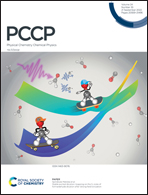Excited-state photochemistry dynamics of 2-(1-naphthyl) phenol: electronic structure calculations and non-adiabatic dynamics simulations†
Abstract
The excited-state proton transfer processes and the formation mechanism of quinone methide of (1-naphthyl)phenol were investigated by combining static electronic structure calculations and non-adiabatic dynamics simulations in vacuum. The results indicated the existence of two minimum energy structures (S0-ENOL-1 and S0-ENOL-2) in the ground and excited states, which correspond to two ESIPT pathways. Upon excitation of S0-ENOL-1 to the bright S1 state, the system relaxes to the S1 minimum quickly in the enol region, for which two decay pathways have been described. The first is a barrierless ESIPT-1 process that generates keto species. Afterwards, the system encounters a keto conical intersection, which funnels the system to the ground state. The generated keto species, in the S0 state, either regenerated the starting material via ground-state proton transfer or yielded the keto product at the end of the simulations. In the other pathway, the system de-excites from the S1 state to the S0 state via one enol-type conical intersection. The dynamics simulations showed that 58.8% of trajectories experience keto-type conical intersection and the rest undergo enol-type conical intersection. Besides the ESIPT-1 process, a new-type ESIPT (ESIPT-2), which was not observed experimentally, was found with the irradiation of S0-ENOL-2. The ESIPT-2 process occurs after overcoming a small barrier (0.9 kcal mol−1) and yields a distinct quinone methide. Our simulation results also showed that the S1 lifetime of S0-ENOL-1 (S0-ENOL-2) would be 437 (617) fs in the gas phase. These results provide detailed and important mechanistic insights into the systems in which ESPT to carbon atoms occurs.



 Please wait while we load your content...
Please wait while we load your content...